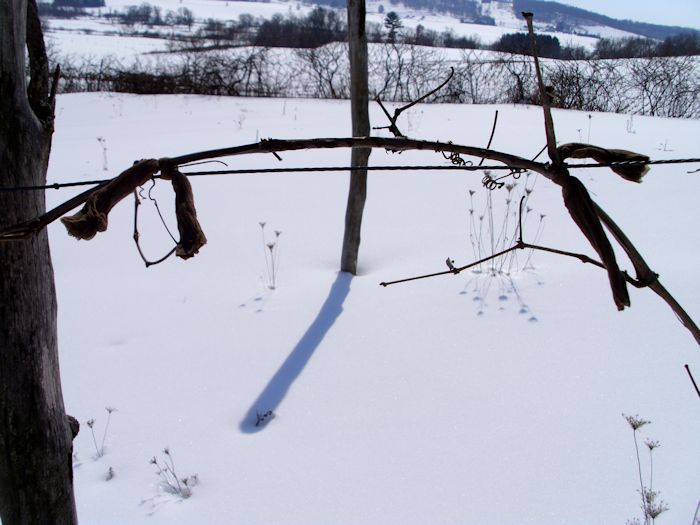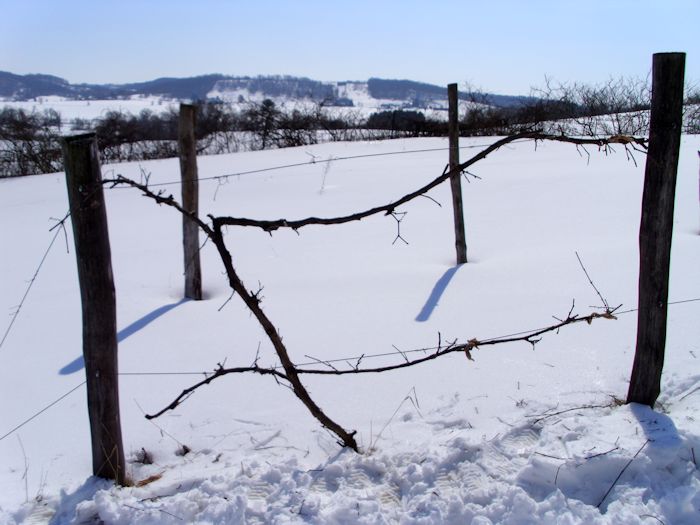Previous posts, Pruning the Grapes (Part 1) and Pruning the Grapes (Part 2), have discussed techniques for pruning your grapes. In most cases, these two posts contain everything needed to prune your grapes using the four-cane Kniffin system. However, pruning grapes sometimes involves more than simply dressing them up. In general, your canes can remain fully productive for many years, but sometimes mother nature steps in and causes severe damage. In my case, all of my young caned died completely and there was nothing to do about it. In addition, two-thirds of the mature canes suffered above ground loss, which is what I want to talk about in this post.
Good hearty canes will come back after a major freeze that kills the top of the plant. No, you won’t get anything in the way of grapes after the top is killed off, but the root stock is well-established and coming back after the freeze is a lot faster and easier than planting new canes. The spring after the freeze will see the old canes looking like gray skeletons and you might think everything is lost, but give your plants time. Look carefully at the ground around the old canes.
The first year after a major freeze will see all sorts of suckers coming out of the ground. Just leave them be. Let them climb up using the old canes as support. What you’ll end up with with look like a horrid mess. The new canes will grow everywhere. That’s fine, just don’t look too often if the mess offends you.
In the spring of the second year, carefully work with the mess. Remove the skinny trunks. One or two the trunks (with their associated canes) will look quite hearty. Leave both for the time being. Also remove the old, dead, trunk and associated canes with extreme care. You don’t want to damage your new canes, which may very well end up resting on the ground for a while. It takes time, but work slowly and carefully. (I find that working through the mess usually requires an hour or perhaps two per plant, so allocated plenty of time and don’t rush.) Eventually, you’ll clean up everything but the two strongest canes.
Now that you’re down to two contestants, carefully look at the canes attached to each of the trunks. You need to consider which trunk has the heartiest canes placed in the right positions for the trellis system you’re using. In my case, I looked for the best trunk with four canes—two upper and two lower. Cut off the trunk you don’t want to use.
It’s important to remember that your plant is frozen and won’t be very flexible during this time of year. Carefully tie the canes to the trellis using a stretchy material that won’t harm the canes. I cut up old, clean pantyhose. It’s stretchy, holds up moderately well in the sunlight, and is inexpensive. Plus, it tends to dry out quickly after getting wet, which means you won’t introduce mold to your plants. You’ll likely need to work more with the canes later in the spring, after they defrost, but before they become productive.
In most cases, mother nature won’t kill your plants. The roots will survive even if the top of the plant is completely dead. Unlike most orchard plants, you don’t normally need to worry about grafts when working with grapes, so using those root suckers is a great way to get your grapes back after being killed off. Instead of the seven years required for new plants, you could potentially get grapes from the restored plants in as little as three years, so the time spent coddling the damaged grapes is well worth the effort. Let me know your thoughts on grape pruning at [email protected].




